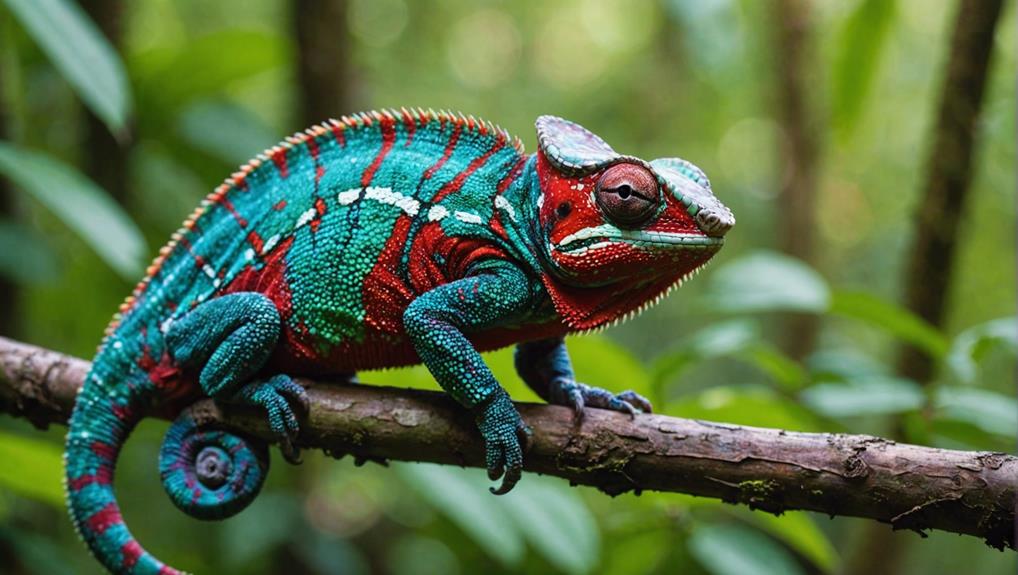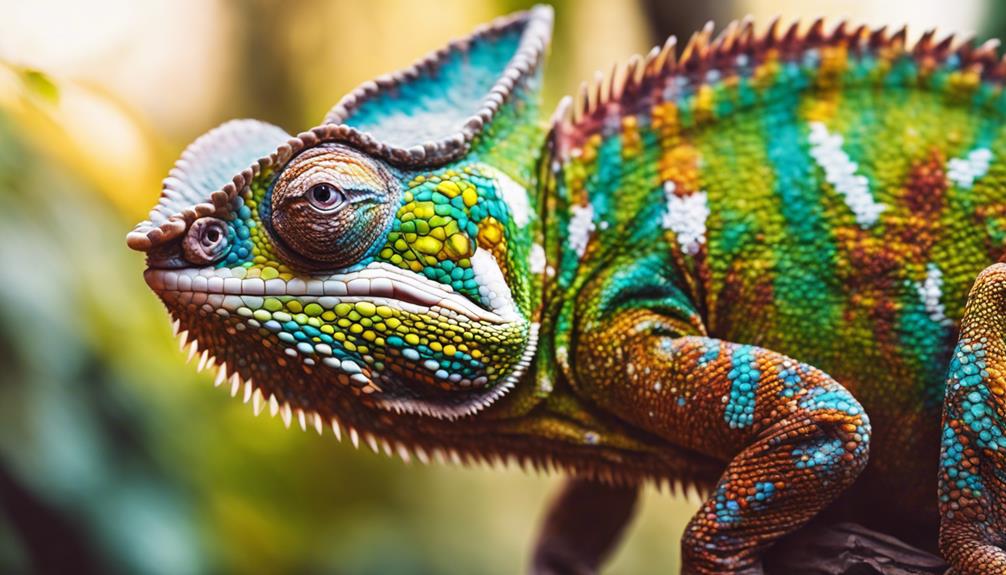In the heart of Madagascar's lush, tropical forests, a masterpiece of nature awaits – the panther chameleon.
This stunning creature thrives in warm, humid conditions, where its vibrant colors come alive. The secret to its mesmerizing hues lies in specialized cells called chromatophores, which expand and contract to create a kaleidoscope of greens, blues, reds, and yellows.
But these color changes aren't just for show – they're influenced by hormonal shifts, environmental factors, and social interactions like mating displays and territorial disputes. Males use bright colors to attract females and deter rivals, while females signal receptiveness or aggression through their color palette.
Their ability to blend into the environment is a survival superpower, helping them avoid predators and hunt with ease.
Want to know more about the fascinating mechanisms behind the panther chameleon's colors?
Habitat and Distribution
Panther chameleons thrive in the lush, tropical forests of Madagascar.
If you're intrigued by these colorful reptiles, you'll find that their natural habitat is as fascinating as they are. They inhabit a narrow geographical range, primarily on the island's northern and eastern regions. This limited distribution means they're dependent on the specific conditions found in these areas.
The climate preferences of panther chameleons are quite specific.
They love warm, humid environments, which makes the tropical climate of Madagascar perfect for them. Temperatures in their habitats typically range between 75 and 85 degrees Fahrenheit during the day, dropping slightly at night. This consistency in warmth and humidity is essential for their survival.
You'll often find panther chameleons in areas with dense foliage, which provides them with ample cover and opportunities to hunt for insects.
The forests of Madagascar offer a diverse array of plant life, giving these chameleons plenty of perches and hiding spots. They're particularly fond of trees and shrubs, where they can blend in and avoid predators.
Understanding the geographical range and climate preferences of panther chameleons can give you a deeper appreciation for their unique adaptations.
If you ever have the chance to visit Madagascar, you might catch a glimpse of these incredible creatures in their natural habitat. It's a reminder of the delicate balance in nature and the importance of preserving such environments. By learning about their habitat and distribution, you're one step closer to understanding the remarkable life of the panther chameleon.
Color Change Mechanism
As you marvel at their vibrant habitat, you might wonder how these chameleons achieve their stunning color changes.
The mechanism behind a Panther Chameleon's color transformation is complex and fascinating. It all starts with hormonal fluctuations and intricate neural pathways that work together to alter the chameleon's appearance.
When a chameleon perceives changes in its environment, its brain sends signals through neural pathways to specialized cells in its skin. These signals trigger hormonal fluctuations that prompt the cells to change color.
The primary hormones involved are adrenaline and melanocyte-stimulating hormone (MSH). Adrenaline is released in response to stress or excitement, causing rapid color changes. MSH, on the other hand, influences more gradual color shifts by regulating the dispersion of pigments.
Your chameleon's brain is constantly processing information from its surroundings, including light, temperature, and the presence of other chameleons or predators.
These environmental factors influence the neural pathways, prompting them to send specific signals to the skin cells. This communication guarantees that the chameleon can adapt its coloration swiftly and appropriately.
In this dynamic process, a chameleon can express a wide range of colors, from deep blues and greens to vibrant reds and yellows.
This ability isn't just for camouflage but also for communication and temperature regulation, making it a vital survival tool in the wild.
Understanding the interplay of hormonal fluctuations and neural pathways gives you a deeper appreciation of the sophisticated biology behind the Panther Chameleon's dazzling color changes.
It's a reminder of the incredible adaptability and freedom these creatures embody in their natural world.
Role of Chromatophores
The secret behind a chameleon's color-changing ability lies in specialized cells called chromatophores. These cells are responsible for the dazzling array of colors that panther chameleons can display. Understanding how chromatophores work will give you a deeper appreciation for these remarkable creatures.
Chromatophores are located in the skin and come in several types, each contributing to pigment production in unique ways.
Xanthophores contain yellow pigments and can give the chameleon a bright, sunny hue.
Erythrophores are packed with red pigments and add vibrant red tones to the mix.
Iridophores reflect light using tiny crystal-like structures, creating shimmering blues and whites.
Melanophores contain dark pigments like melanin and can deepen the chameleon's color to darker shades.
Leucophores, often present in other animals but less so in chameleons, reflect all wavelengths of light, adding a white or silver appearance.
The magic happens when these cells expand or contract, altering the skin's color and pattern. For example, when a chameleon needs to blend into a green leafy environment, the xanthophores and iridophores might expand to dominate the skin's appearance, while melanophores contract.
This intricate control over pigment production and cell structure allows the panther chameleon not only to hide from predators but also to communicate with other chameleons. So, next time you see a panther chameleon, remember that its stunning colors are the result of a fascinating interplay of chromatophores working in perfect harmony.
Mating and Color Displays
When it comes to mating, you'll find that Panther Chameleons use vibrant color displays as part of their courtship rituals.
Males change their colors to attract females, signaling their readiness to mate and their dominance over other males.
Females respond to these displays by either signaling receptiveness or showing disinterest through their own color changes.
Courtship Rituals
During courtship, male panther chameleons showcase vibrant color displays to attract females and assert dominance over rivals. These visual signals are a vital part of their mating rituals, often leading to territorial disputes among competing males.
When a male panther chameleon spots a potential mate or rival, he'll flash a series of bright, bold colors to communicate his intentions and status.
Dazzling greens and blues: Announcing his presence and readiness to mate.
Fiery reds and oranges: Indicating aggression towards other males.
Subtle shifts in hue: Gauging the female's interest.
Rapid color changes: Displaying excitement or agitation.
Contrasting patterns: Highlighting his physical fitness.
These color displays aren't just for show; they serve as a key means of communication in the chameleon's world. By understanding these visual signals, you can appreciate how these creatures navigate their social structures and reproductive strategies.
The interplay of light and color in their skin is a remarkable demonstration of nature's ingenuity, offering a glimpse into the complex lives of panther chameleons. The freedom to express and compete through color is a fascinating aspect of their existence.
Color Change Triggers
Panther chameleons change their colors in response to various triggers, with mating displays and social interactions being primary catalysts. When a male panther chameleon encounters a potential mate, his body undergoes hormonal changes that trigger vibrant color displays. These displays can range from bright reds and yellows to deep blues and greens, designed to attract the female's attention and ward off rival males.
In addition to mating, social interactions can also prompt color changes. When a chameleon feels threatened or stressed, a stress response causes it to darken its colors, signaling aggression or the need to establish dominance. Hormonal changes play a key role in these transformations, acting as internal signals that help the chameleon navigate complex social dynamics.
To better understand these triggers, here's a quick breakdown:
| Trigger | Response | Purpose |
|---|---|---|
| Mating Opportunity | Bright Colors | Attract females, deter rivals |
| Rival Encounter | Dark Colors | Signal aggression, establish dominance |
| Environmental Stress | Dark Colors | Camouflage, reduce visibility |
| Social Interaction | Color Variation | Communicate mood and intentions |
Understanding these triggers helps you appreciate the panther chameleon's ability to adapt and thrive in its environment. Their color changes are not just for show—they're essential for survival and reproduction.
Female Response Patterns
Female panther chameleons also exhibit distinct color changes, primarily signaling their receptiveness to mating and their overall health status. When a female is ready to mate, she displays vibrant, welcoming hues. These colors act as behavioral cues to attract potential mates.
However, if a female isn't interested or already gravid (carrying eggs), she'll show aggression signals through darker, more intense colorations. You'll notice these signals in various situations, from mating displays to deterring unwanted advances.
Imagine this vivid palette:
Bright oranges and pinks: Indicate receptiveness to mating.
Dark browns and blacks: Signal aggression and unavailability.
Pale greens: Reflect a neutral state or general health.
Reddish hues: Can indicate stress or discomfort.
Spotted patterns: Often show up when a female is ready to mate.
These color changes are more than just stunning; they're essential communication tools. By observing these visual cues, you can gain insight into the female's mood and status. Understanding these signals helps in ensuring the well-being of these fascinating creatures. So, next time you see a female panther chameleon, take a moment to decode the story her colors are telling.
Camouflage and Survival
When you think of the panther chameleon, its ability to change colors likely comes to mind, but it's more than just a beautiful display.
This adaptive color change helps it avoid predators and blend into its surroundings.
Environmental triggers like light and temperature play a vital role in this survival mechanism.
Adaptive Color Change
Adapting their skin color, panther chameleons masterfully blend into their surroundings to evade predators and hunt effectively. These stunning creatures owe their color-changing ability to their evolutionary origins and genetic mutations.
Over time, chameleons developed specialized cells called chromatophores, which allow them to display a spectrum of colors. By adjusting these cells, they can seamlessly merge with their environment.
Imagine a chameleon in its natural habitat, using its adaptive color change to:
- Mimic the vibrant greens of tropical leaves
- Blend with the earthy browns of tree bark
- Mirror the bright hues of flowers
- Camouflage against the rocky terrain
- Match the subtle shades of a shadowy forest floor
This remarkable skill is more than just a visual spectacle; it's essential for their survival.
Predator Avoidance Strategies
Panther chameleons employ a variety of predator avoidance strategies, with camouflage being one of their most effective tools for survival. By blending into their surroundings, they can often evade the keen eyes of predators. Their ability to change colors isn't just for show; it's a critical survival mechanism. When danger lurks, you'll see them seamlessly merge with foliage, making them nearly invisible.
Another essential strategy they use is nocturnal behavior. By being active at night, panther chameleons reduce the risk of encountering daytime predators. This shift to nocturnal activity allows them to move more freely and safely under the cover of darkness.
Escape tactics also play a crucial role in their survival. If a predator gets too close, panther chameleons can employ swift movements and unpredictable changes in direction to confuse and evade their pursuers. Their agility and quick reflexes often give them the upper hand in a chase.
In essence, the panther chameleon's blend of camouflage, nocturnal tendencies, and escape tactics creates a robust defense system, allowing these stunning reptiles to thrive in their natural habitats while maintaining their freedom from predators.
Environmental Triggers
In response to environmental triggers, panther chameleons adapt their coloration to blend seamlessly into their surroundings, ensuring their survival. By adjusting their skin tones, they can evade predators and communicate with other chameleons.
When light intensity changes, it signals the chameleon to alter its colors. Bright light might cause a shift to more vibrant hues, while dimmer conditions lead to darker, more subdued shades. Temperature fluctuations are another key factor. As temperatures rise or fall, the chameleon's skin reacts, modifying its pigmentation to either absorb or reflect heat more efficiently.
Panther chameleons change their color in the following scenarios:
- Hiding from predators: Blending into leaves or branches.
- Basking in the sun: Turning darker to absorb more heat.
- Cooling down: Lightening up to reflect sunlight.
- Communication: Displaying bright colors to attract mates.
- Territorial disputes: Flashing specific patterns to ward off rivals.
Environmental Influences
The environment plays a paramount role in shaping the behavior and physical adaptations of a panther chameleon. You'll find that temperature fluctuations and humidity levels are essential in determining the vibrant colors and overall health of these fascinating creatures. When the temperature changes, a panther chameleon can shift its colors to regulate its body temperature. In cooler environments, they tend to display darker colors to absorb more heat, while warmer conditions lead to lighter hues to reflect excess heat.
Humidity is equally important. In their natural habitat, panther chameleons thrive in areas with high humidity. Proper humidity levels maintain that their skin stays hydrated, which is necessary for shedding and maintaining those stunning colors. If the air is too dry, it can lead to health issues and duller coloration. Striking the right balance in environmental conditions is key to witnessing the full spectrum of their color-changing abilities.
Here's a quick guide to understanding the environmental needs of a panther chameleon:
| Environmental Factor | Ideal Range | Impact on Chameleon |
|---|---|---|
| Temperature Daytime | 75-85°F | Promotes activity and vibrant colors |
| Temperature Nighttime | 65-75°F | Prevents overheating and stress |
| Humidity Level | 50-70% | Maintains proper hydration and skin health |
| Light Exposure | 10-12 hours | Mimics natural habitat and regulates behavior |
| Ventilation | Moderate | Prevents respiratory issues and mold growth |
Panther Chameleon Care
Caring for a panther chameleon requires attention to detail and an understanding of their unique needs. These vibrant reptiles thrive when their specific care requirements are met. You'll need to focus on their habitat, diet, and overall health to keep them flourishing.
First, let's talk diet requirements. Panther chameleons primarily eat insects like crickets, mealworms, and roaches. To keep them healthy, you should dust their food with calcium and vitamin supplements. Remember, a varied diet is key to preventing nutritional deficiencies.
Health concerns are another critical aspect. Regularly check for signs of illness such as lethargy, lack of appetite, or unusual coloration. These could indicate issues like respiratory infections or metabolic bone disease, both of which require prompt veterinary attention.
Creating the right environment is essential. You'll need:
- Enclosure: A large, well-ventilated cage with plenty of vertical space for climbing.
- Lighting: UVB lighting to help them synthesize vitamin D3, vital for bone health.
- Temperature: A gradient from 70°F to 85°F, with a basking spot around 90°F.
- Humidity: Maintain levels between 50-70% by misting the enclosure several times a day.
- Plants: Live foliage to mimic their natural habitat and provide hiding spots.
Make sure to clean their enclosure regularly to prevent the buildup of bacteria and pathogens. Pay attention to their behavior and physical condition, and don't hesitate to consult a vet if you notice anything off.
With proper care, your panther chameleon will display its stunning colors and lively personality, making it a fascinating pet to observe and enjoy.
Conclusion
The panther chameleon is a fascinating creature with vibrant color displays influenced by its habitat, mating behaviors, and environmental factors.
Understanding its unique color change mechanism and the role of chromatophores provides insight into its survival strategies.
If you're considering keeping one as a pet, it's essential to replicate its natural environment for proper care.
With the right knowledge, you can appreciate and support the well-being of these stunning reptiles.


